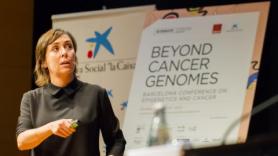3. From stem cells to therapy
Although it is still quite controversial, it seems that in many cases tumor stem cells come from the stem cells found in the tissues themselves, those in charge of regeneration. So, explained Andreas Trumpp, professor at the German Cancer Research Center (DKFZ), these cells “should be protected: as a mutation here becomes amplified a million times.” To do so, a huge proportion of the most powerful ones are in a quiescent state, lying dormant (by not dividing, the potential for mutation is minimized). But sometimes (when faced with an infection, blood loss or chemotherapy), they must be activated to replace lost cells. This is when Myc, an essential protein, comes into play.
Myc is what is known as a transcription factor: a protein that bonds with DNA and switches on the expression of one or more genes. In this case, it is so powerful that it modifies activity in up to 15% of our genes. For Trumpp, "It is the gas pedal of cell activity," and what stem cells use to come out of their dormant state and regenerate tissue.
And not only stem cells. The vast majority of tumors show Myc activation. It is a command center; the great target everyone was looking to block.
But that seemed impossible, as explained Laura Soucek, ICREA professor at the Vall d’Hebron Institute of Oncology (VHIO): “When I was a student everyone told me that Myc couldn’t be treated and shouldn’t even be touched.”
Laura Soucek: "When I was a student everyone told me that Myc couldn’t be treated and shouldn’t even be touched". Her research seems to have taken down this hypothesis.
It wasn't treatable because its characteristics and its location inside the cell nucleus made it nearly impossible to reach. And it shouldn't be touched because of its function was so important that the side effects could be devastating. However, Soucek’s research uncovered one surprise after another and seems to have taken down all of those hypotheses.
To disprove the first, they used biotechnology. They “designed” transgenic mice adding a gene that synthesized a Myc inhibitor, which could be activated just by adding an antibiotic. In this way, they were able to block its action from the inside. The results? It was surprisingly effective in treating lung tumors and glioblastomas, a particularly aggressive type of brain tumor that currently has no effective therapy. The surprise? Although they still don’t know exactly why, the side effects weren't catastrophic at all; they were limited and reversible, at least in mice.
The second hypothesis was overturned on its own, as if by a happy coincidence. For a treatment based on Myc inhibition to become a reality, there must be an effective drug, as transgenic patients aren't an option. However, Myc acts in the cell nucleus, which is very hard to reach. The surprise came when the product of the transgene -called Omomyc-, which is large and wasn't even considered a candidate, was shown to have special traits that induce tumor cells to capture and collect it. In fact, studies underway have shown that it can reach the lungs even when administered intranasally. This is what they're working on now, concluded Soucek, “Going from genetics to pharmacology and making Omomyc a viable therapeutic option to fight cancer”.
"Going from genetics to pharmacology and making Omomyc a viable therapeutic option to fight cancer is in what we are working now"



